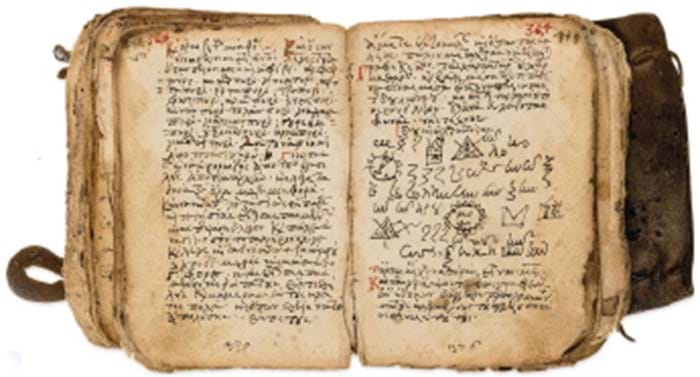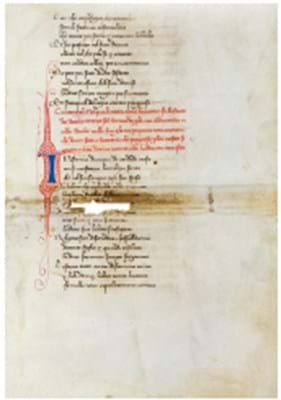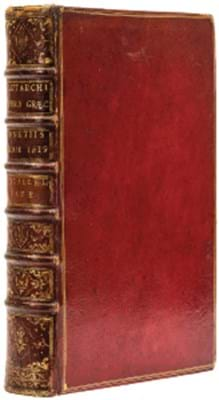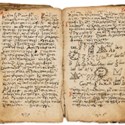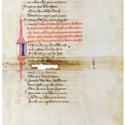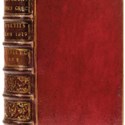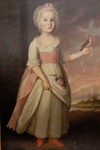Books and works on paper
A COLLECTION of proverbs compiled by Zenobius, a Greek sophist who taught rhetoric in Rome during the reign of the Emperor Hadrian, was one of many early printed books offered at Forum Auctions (25/20/12% buyer’s premium) on January 25.
Selling for £15,000, this 1497 editio princeps of his Epitome Proverbiorum Tarrhaei et Didymi drew on older collections, but Zenobius acknowledges earlier work by Lucillus of Tarrha and Didymus Chalcenterus in the full title.
The Forum copy was a washed and pressed example in an early 19th century English binding of crimson morocco gilt, but it was also a copy with an appealing provenance.
Edited by the humanist Benedetto Riccardini, this copy of the first book produced by the Florentine printing house of Filippino Giunta was once part of Richard Heber’s vast library and later passed to Beriah Botfield.
The latter, heir to a Shropshire ironworks fortune, Ludlow MP and antiquary, left his library – in which early Greek texts were a key part – to the Marquesses of Bath, having convinced himself that he was a cousin to the Thynne family.
In 1994, when some of the books from the Botfield bequest to the Longleat library were sold at Christie’s, this one reached £11,000, but a couple of other ex-Botfield/ Longleat lots in the Forum sale proved less successful.
A 1498 Venetian edition of a collection of letters once believed to have been written by Phalaris, a 6th century BC Sicilian tyrant – but which probably date from some eight centuries later – sold at £10,000, some £4000 less than the 1994 price.
Early printed books can at times prove difficult to move, as other leading salerooms well know, and the ex-Botfield copy of the 1500, Riccardini/Giunta edition of the writings then ascribed to Orpheus was one of three lots in this auction left unsold on £20,000-30,000 valuations.
Bound in red morocco gilt in the early 19th century by Charles Lewis, the Orpheus volume had sold in 1994 at £18,000.
A simple, elegant red morocco gilt binding produced by Roger Payne, the most famous English binder of the late 18th century, doubtless contributed to the £7000 success enjoyed by a 1519 Aldine edition of Plutarch’s ‘Lives’.
Payne had a known partiality for strong drink, something that might account for the incorrect date of 1619 seen on the spine, said the cataloguer, and for his elaborately constructed but not always entirely accurate bills.
Payne’s Plutarch binding is illustrated above right, but while I should like to have shown another produced by the London binder John Reynes for a first printed edition of the Greek Liturgy (Rome, 1526), it proved impossible.
The dark brown calf binding over wooden boards, blind-stamped with panels featuring the English royal arms and the Tudor rose, does not lend itself to suitable reproduction.
Those panels are in the first state, showing the pomegranate badge of Catherine of Aragon that was in 1532 dropped by Reynes and replaced with one of Henry VIII’s badges, a cock.
In its original ‘alla Graeca’ binding of blind-tooled calf, a very rare and entirely unsophisticated 1583, Venetian edition of the Greek Orthodox hymnbook, known as Oktoechos (literally ‘eight-tone’), also sold well at £6500.
All of the lots noted above came from a single property, but other early printed highlights included, at £20,000, the 1497 edition of Gafurius’ Practica Musicae illustrated and described in ATG No 2278.
Comedy value
Manuscript material included an unrecorded and only recently discovered leaf from a mid- 14th century, Florentine vellum manuscript of Dante’s Commedia that made a double-estimate £14,000.
Folded in half (with some resultant discolouration and loss) for use as binding material in a quarto volume, this leaf, with its coloured initial and flourishes (see illustration far left) contains portions of two cantos of the ‘Paradiso’. On the recto is the beginning of Canto xxxi, in which Dante introduces his description of Paradise as a snow white rose.
Dating from the first half of the 15th century and still in its original, if now somewhat stained, rubbed and worn binding, a Florentine manuscript of Boccaccio’s celebrated biography of Dante failed to sell on an estimate of £30,000-40,000. In 1997, in one of the many sales that dispersed the Giannalisa Feltrinelli library at Christie’s, it had made £14,000.
A small quarto Greek medical manuscript, or notebook on paper, probably originating from Crete in the first half of the 16th century, running to 266ll in all (many of them loose) and in an early flap binding of black goatskin, made a doubleestimate £22,000. See illustration top left.
Endlesly copied, such iatrosophion or ‘medical wisdom’ manuscripts, in which botanical, astrological, even magical texts feature alongside the medical guidance, were used predominantly by healers, midwives, priests and monks.


